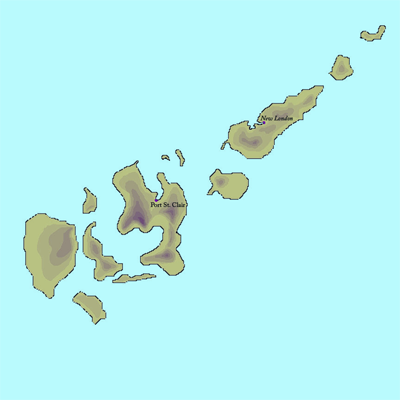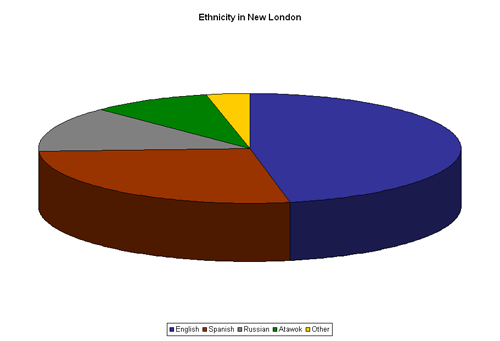New London (Azazia colony)
New London is a royal crown colony of the United Kingdom consisting of 12 large islands and six smaller more distant islands located within the tropics. The islands occupy a total area of 29,000 km² with the capital, New London, located on the second largest island. Blessed with mineral resources and burdened with a hostile native population the colony continues to absorb both men and materiel from the UK’s armed services.
 Map of New London |
|---|
Contents
History
New London remained undisturbed until the mid-20th century and thus allowed a small iron age civilisation to develop until the arrival of settlers from the United Kingdom of Azazia, who promptly settled the town of New London in 1953.
Having mastered coastal seas through the use of catamaran sailing vessels the Atawoks, a corruption of the native’s distinction for themselves, fiercely resisted UK colonization once going so far as to raze a small settlement near the capital to the ground without a single survivor. Although the iron spears and swords of the natives were ultimately of no use against the settlers, the wounds inflicted were horrible and to this day stories of native “savagery” have kept the settler population low and largely confined to two communities.
By 1966, however, the UK had developed and fortified a small portion of New London into a military base from which UK forces launched sorties into native lands and secured the peace. Yet, by the time of these constructions diseases from the settlers had entered into the native population and by 1970 an estimated pre-Azazian population of 350,000 individuals had dropped to a mere 25,000.
The drastic reduction in population allowed the UK to spend more money per-capita on educational and job-training programmes to better integrate the Atawoks into the colony’s political, cultural, and economic life. And although the economic troubles of the late 1980s further heightened the colony’s dependence on the UK, the quality of life for all inhabitants has slowly been on the rise and in 2006 all indications point to a continued development of the colony.
Geography
The Royal Crown Colony of New London occupies the Sebastian Archipelago, discovered in the 16th century by Spanish explorer Rodrigo Sebastian under employ of the British Royal Navy. However, his conclusions noted the island’s lack of sustainable resources and rocky coasts. In many respects his report was correct.
The archipelago rests atop a hotspot that produced the volcanic islands over the past several millions of years. The most notable features of the archipelago are the comparatively massive size of St. Charles Island and Sebastian’ Island. The first island is the chain’s second and actually is geologically constructed of three separate extinct volcanoes. St. Charles boasts an indented coastline that is favourable to harbours and bays where ships can anchor – and it is on Charles Harbour where the city of New London is built.
Sebastian’s Island is the largest and most interesting in the chain. Once the island was connected to the five islands laying off its south and west coasts; however, in 1892 a massive eruption took place that literally cracked the mountain into pieces with the shattered caldera forming the deep Rodriguez Channel and the Gulf of Cualito, where the Royal Navy has constructed an overseas naval station with the purpose of docking and servicing its super dreadnoughts while overseas.
However, the massive heights of the crater walls that remain above the ocean create deserts for the five islands off the coast of Sebastian’s Island and with the exception of Port St. Clair, which rests upon the rain-drenched windward side of the now-extinct volcano, there are no permanent habitats.
The remaining islands feature mild temperatures year round with precipitation largely falling in the winter months. In combination with the high altitudes and high precipitation of the northern islands, the islands with significant peaks boast a variety of ecosystems from tropical forests along the coast to an alpine climate near the peaks and summits of the volcanoes.
Owing to their volcanic origins the islands offer plentiful reserves of both base and precious metals as well as several off-shore oil and gas reserves. However, mineral resources are not the only type of geographical advantages exploited by the colony as the great level of biodiversity has allowed the natives to domestic several types of fruits and roots that are of nutritional value – and quickly a commercial value as they begin to become popular in the UK.
Economy
As noted before, the primary impetus for New London’s economy is that of the resource-driven primary industries such as mining, logging, fishing, and oil drilling. As of yet there are relatively few commercial and financial services on the island as the average income of the population falls below $20,000 USD. This restricted purchasing power and the distance between the colony and the markets for its resources have caused a noticeable disparity between the colony and the mother country, the only colony being worse off is that of Port Elizabeth.
For now the UK government remains the largest investor in the colony as it seeks to develop an infrastructure capable of transporting goods and services between the islands to allow for self-development, although any such hopes are placed securely in the long-term plans as the island will likely remain dependent on UK aid for years to come.
Demographics
 Ethnicity in New London |
|---|
With the majority of the Atawok population dieing off in the latter half of the 20th century the island’s ethnic background has shifted to one dominated instead by English settlers from the Home Islands. Additional immigration by people of Spanish blood owes to the historic impact of Spaniards in the discovery of the island.
Recent demographic trends, however, indicate that as the Atawok population begins to accustom itself to Western diseases their population has begun to steadily creep back upwards to the point where its estimated 2006 population will be near 37,000 individuals.
